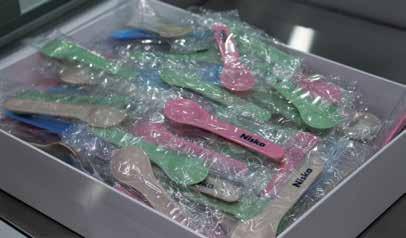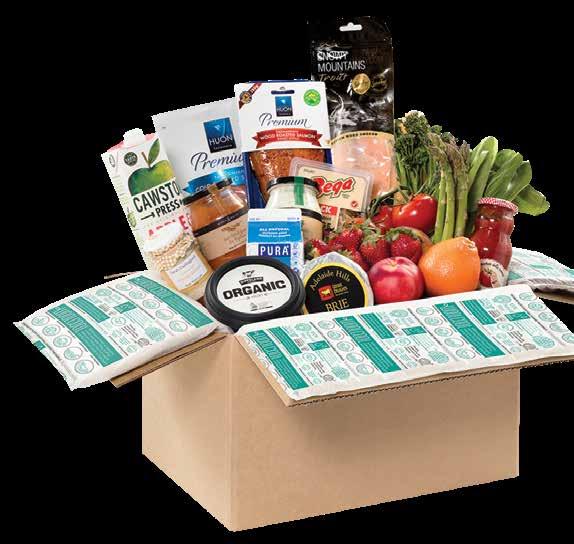
5 minute read
ROBOTICS
Even though robots are at the forefront of the Niska store, there is still room for the human element in retail outlets.
Easy to program cobot complements novelty ice-cream outlet
When digital and robotics solutions specialist Niska wanted to open a retail ice-cream outlet, it needed something different, so it contacted ABB. Food & Beverage Industry News explains why.
It can be hard to make a dollar in the retail world. Overheads can be high, margins small, good staff not easy to find, and with the online presence of Amazon, Alibaba and a myriad of other smaller players, competition is fierce.
But people will always need food. And while a recent report from Brick Meets Click has found that online grocery shopping makes up 5.5 per cent of total spend in the category in the US (closely mirrored here in Australia) and is growing, people

still like to eat out. And there is still compulsion buying at your favourite fast food outlet, or ice cream store.
Again, competition is fierce so as well as varying the products that are on offer, but also vary the shopping experience, too. This is something digital and robotics solutions company Niska thought when it mooted the idea of opening an ice-cream store in Melbourne’s CBD. Its solutions are aimed at the retail industry, which is why it decided on a novel approach – robots serving customers. The idea of robots serving people has been the purview of science fiction since the genre was invented, however now it is coming to fruition. Although the concept is all Niska’s, the company needed help to bring its idea alive. Enter ABB, who among other things, specialises in robotics.
John Rieusset leads ABB’s business activities in the food and beverage industry. He is also the marketing manager for ABB’s Robotics and Motion businesses. The YuMi robot is known as Tony and adds the toppings to the ice cream, and serves them to customers. A key aspect of Niska’s operation is ABB’s YuMi robot – or cobot as they prefer to call it – which is a popular model that is being used in factories throughout the world.
While the aesthetic side of what the robot looks like in store are a novelty – and Niska are first to admit that is part of the reason for opening the outlet – Rieusset said that the practical aspects of YuMi were the main selling point.
“In terms of deploying YuMi, one of the key aspects as to why Niska was interested was the fact it could be redeployed to do different tasks and it’s very easy to program,” he said. “The robot has what is called a lead-through
programming functionality whereby you don’t need a traditional robotics programmer. You basically lead the robot through the motions; you take its arms and you manoeuvre it to do the tasks you want. It records those motions and then it effectively plays it back. It is something that even a child could grasp.”
When new technologies start emerging – even ones that have been mooted for decades – there is usually a backlash from those most affected. In the case of cobots, it is those who work in some aspects of the retail environment. However, Rieusset believes that any thoughts of the demise of the retail worker are premature.
“For this particular concept it is effectively a novelty. In terms of a commercial concept, it’s not something that is necessarily something that is going to work in every retail environment,” he said. “Where we would see robots being introduced in a retail environment would be more in the back room activities. For example, some of the large fast food chains. They are very systematic in their processes. If you go behind of the big burger chains they have everything set up in modules and it like a production line and that’s where we would see robots becoming more involved in that food services industry. It is likely that robots will be introduced at the point of sale, but it’s not going to replace every point of sale job in every aspect of the food industry. That is unlikely.”
Labour savings A key ingredient as to why some companies – especially in the supply chain – have adopted robotics is the cost savings on labour. What is the return on investment for putting something like a YuMi robot to work?
“The ROI for a YuMi robot can be as little as six months for some picking and packing applications,” he said. “It is a no brainer to introduce a robot, for example, in

YuMi cobots dispense ice cream and the Niska store.

the picking and packing of sweets. We have a YuMi robot installed at a company in Finland. It is integrated into the production line and it is involved in the picking and packing process.”
Which begs the question; is there a perception that robotics as a solution are seen as expensive?
“I would say that was true,” said Rieusset. “It’s really a case of educating end users that robots can be introduced into their processes. It’s a case of increasing the maturity and understanding generally out in industry as to where that can occur. It’s not only about increasing throughput on production lines – some of the processes are highly repetitive, which creates issues of OH&S risk in businesses. Being able to introduce those robots into the environment is also about de-risking the business in other areas.”
Rieusset also points out that ABB and its ABB Authorised Value Providers have a nationwide network of service engineers that are available if the robots need servicing. He also said that even though robots do have a function in the Niska store, humans do still have a role to play.
“The three robots at the store are involved in the ordering and serving process of the ice cream,” he said. “Niska also has a human staff member within the store that guide people through the ordering process. It’s not as if you walk in and are greeted by robots and you’re left alone to place your order. There is a human element. The robots were introduced to that ice cream store concept just as much as a novelty as anything else.”
YuMi collaborative robots can be deployed into a lot of industries besides the food and beverage sector, including electronics, medical and pharmaceutical. F










